#dialectical
Explore tagged Tumblr posts
Text

#dark#eerie#goth#creepy#spooky#horror#halloween#haunted house#black#pink#coexist#both can be true#dialectical#punk#nu goth#emo#balance
22 notes
·
View notes
Text

12 notes
·
View notes
Text
A dialectical dilemma in DBT is when there are two types of actions, attitudes, or interpretations (behaviors) that you can do in response to a situation that you're in, and DBT is about finding a way to do behavior that makes your life better, rather than simply going full bore freakout or non-verbal catatonic (or any other ineffective behavior in between)
15 notes
·
View notes
Text
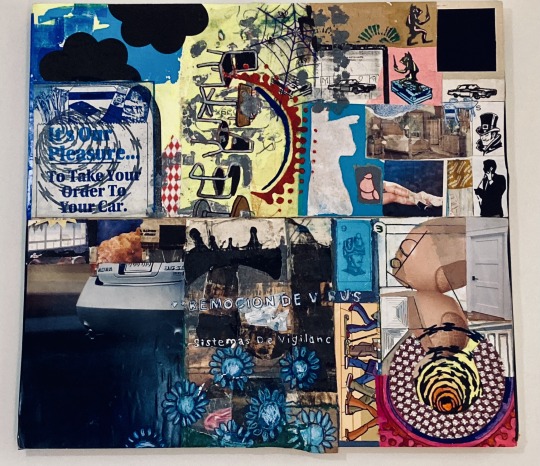
Altima (ultimate)/It’s Our Pleasure (2024)
collage, gouache, colored pencils, silkscreen ink, wax pastels, and acrylic on card
28” x 26” overall (2 pcs)
#art#collage#2024#mixed media#dialecticalrealism#dialectical#political art#painting#contemporary art
12 notes
·
View notes
Text
By: James Lindsay
Published: Jun 7, 2024
From the woman (pretending to be male) who was the Satanic designer whose work led in part to the gigantic Target boycott last year: "transitioning is alchemy." I would like to discuss this Socially Gnostic/Hermetic statement in some depth to clarify what gender ideology does.

The first thing to understand is the term "alchemy." Alchemy is a magical process with particular metaphysical commitments beneath it. The basic idea is believing that some essential substance can be transmuted into some other essential substance, but it goes deeper than this.
Alchemy rests on a metaphysical commitment to a kind of Gnostic and Neoplatonic dualism that sees true substances as divine and physical/real substances not just as mundane but as fallen, vulgar, and contaminated. Alchemy is an esoteric process of freeing the divine from the Fall
"Transitioning is alchemy" is therefore a statement referencing a fundamentally spiritualist belief that there is a true substance to the person that is being liberated from its fallen form, which imprisons it, through a magical process of transmutation. It is (dark) magical.
Perhaps the greatest contemporary expositor on alchemy is George Soros, who explains that its purpose is "operational success." He claims alchemy doesn't obtain in the physical sciences; only in the social sciences, which should be called "social alchemy."
This point from Soros is incredibly important to understanding the phenomena of "gender transition" and "transgender," thus bearing on all of "gender ideology," which is a shorthand for "a critical constructivist ideology of gender."
First, note that Soros identifies social alchemy explicitly as a dialectical process, which locates it not only in the same current as Marxism but also in the Hermeticism (Gnostic occult belief) I already suggested. That's a challenging term, but we can make sense of it.
A good lay definition for "dialectical" would be "blending truths and lies for operational purposes." That is, it's manipulating people's understanding of a circumstance so that they'll adopt actionable beliefs with political consequences. It explicitly relies upon distortions.
Soros says explicitly that what moves history isn't truth but the difference between truth and what people actually believe (or can be led to believe). That is, he says history moves through "fertile fallacies," i.e., politically productive errors or lies.
Social alchemy is therefore achieved in the following way: Conditions are set to lead significant numbers of people to believe a politically actionable lie (or set of lies) so that they then act upon them. The lie then becomes consensus or convention, i.e., socially "true."
You will notice, of course, that this is the same method and purpose of propaganda as infamously explained by Joseph Goebbels. The idea is that a lie repeated often enough gets treated as true. This process has been called "social reification" or "legitimation by paralogy."
There's a lot here, but what it all tells us is that the point of gender ideology isn't individual transition; it's *social transmutation*. It has little or nothing to do with the individual in question, who is little more than a wedge to transform social beliefs and attitudes.
Put more plainly: unlike the older practice of transsexualism, which was/is individual, *your participation is required* in transgenderism. In transgenderism, what matters is what people will accept and believe about the "transgender" person. Transmutation is a social thing.
In other words, just like Soros indicated, the alchemy of gender transition is a social phenomenon. It is not an individual process that obtains in physical reality; it is a social process that obtains in social "reality" through social reification/legitimation by paralogy.
That means that "gender transition" is a matter of people believing "gender transition" is a real thing, which is to say that it isn't a "transgender" person daring to live in the world but one forcing everyone else to live in a world that doesn't exist. That's a big difference.
The foundational literature in Queer Theory, (Foucauldian) Sexuality Theory, Feminist Theory, etc., all attests to this understanding. The "soul" (divine part) is not imprisoned by the body so much as the body is imprisoned by the soul. That's Foucault's and Butler's view.
What it refers to is the idea that one's soul (who you are) is actually a social phenomenon, a constructed part of the broader Geist (dialectical Spirit) of society. Bulter's view (following Foucault) is that the Geist constrains the soul so that it is "scripted" onto the body.
That is, people do with their bodies what they believe they are supposed to do with their bodies. If they are male, society (Spirit) tells them to present as masculine (soul), so they live and present that way (body). Hence "sex assigned at birth."
Critical constructivists believe every phenomenon is the result of social reification. A doctor "assigns sex at birth" and then society, "obsessed with genitals," creates conditions that socially reinforce expectations about one's sex/gender in a giant society-wide drag show.
They also believe that by adopting critical constructivism ("Woke"), a person can see through this imprisoning dynamic and set the divine part of themselves free from the "controlled" set of social expectations (cf. Demiurge and his archons). It's a Gnostic Cult.
The point isn't to see through it (understand society), though. It's to transmute society (change it!). That is, the point is to use "gender transition" to force society to accept and socially reify the critical constructivist ideology of gender under "gender transition."
That's the alchemy, and it happens SOCIALLY. Again: your participation is REQUIRED.
Their view is that since all reality is socially reified reality, they should seize the means of production of social reification to maximize spiritual liberation of imprisoned souls.
"Transitioning is alchemy" is deadly serious, then, as visualized with the skeletal artwork at the top. It is also inherently totalitarian, requiring mass "ideological remolding" to create the social reification necessary for it to be "socially real" ("valid").
This is the "gender ideology" (oc)cult religion, which requires universal belief.
Again, it isn't about "transgender" people daring to live in the world. It's about using "transgender" people to force everyone to live in a world that doesn't exist.
Incidentally, this also explains in part why Leftism always produces radically ugly presentations in people, which is a tragedy. By presenting their fallen, vulgar form as ugly and degenerate, they seek to force you to recognize the divine part within themselves.
#James Lindsay#transitioning is alchemy#alchemy#magical thinking#gender transition#your participation is required#pronouns#pronoun culture#Hermeticism#gnosticism#dialectical#social alchemy#occult#gender cult#gender ideology#gender identity ideology#critical constructivism#Transmutation#religion is a mental illness
5 notes
·
View notes
Text

Formal logic: which conclusion follows from these premises?
Dialectical logic: what are the conditions for this apparently given content? pic.twitter.com/OG6h7J7NUz
— West Virginia Mecha Tankie (@HUMANMAXXING) September 25, 2023
#logic#leftblr#marxism#philosophy#Marxist#dialectical#social issues#progressive#nature#capitalism#relationship#leftism#posts#postss#posted without comment
2 notes
·
View notes
Text
me: haha i’m a bi lesbian. i’m futch. i am several walking contradictions. i am on so many levels of irony right now. i contain multitudes. i am one with the universe. i am a goddess. i don’t have to explain shit. you either get it or you don’t. i don’t care what anyone else thinks.
someone else: bi lesbians aren’t real. futch is stupid.
me: ….
me: HEY FUCK YOU OKAY
5 notes
·
View notes
Text
not only are there no bad languages there are also no bad or annoying dialects
#Every dialect I’ve ever complained about was internet peer pressure btw#we hadn’t known each other long enough to be friends
45K notes
·
View notes
Text
#philosophy#existentialism#explorations of thought#explorations of emotions#explorations of existence#human nature#uplifting#dialectical#metaphysics#uncertainty#radical kindness#love#joy#animism
0 notes
Text
i notice that i and many people in my area tend to omit the "to be" in phrases like "the cats need to be fed" and "your kid wants to be held" but i don't thiiink it's standard english and i'm curious if it is a regionalism or what
bonus: say what you voted and add what general region you're from/what dialect of english you speak (if you feel comfortable doing so)
#eliot posts#linguistics#polls#i do it on some occasions when i'm being more casual and my dialect is like pittsburgh area/north appalachian#was talking abt this w my friend (from mexico) last night#they said they think they've mostly just heard it from me. and maybe also from the mcelroys#which would track if so bc the mcelroys are from west virginia which is close to where i grew up#probably a little bias here towards ''i heard others do it'' cuz well. yinz are following me who does that#also cuz im a taz fan so many of yinz are too and would have heard the mcelroys do it (if my friend is remembering correct that they do it)
4K notes
·
View notes
Text
Studying linguistics is actually so wonderful because when you explain youth slang to older professors, instead of complaining about how "your generation can't speak right/ you're butchering the language" they light up and go “really? That’s so wonderful! What an innovative construction! Isn't language wonderful?"
#linguistics#gen z slang#english#as people in the reblog pointed out!#most gen z slang comes from (or was appropriated from) aave#honestly I was just excited to talk about how people in my field actually get excited about non standard uses of English#instead of ridiculing speakers#and I tagged incorrectly and didn’t point out the very real issues of language and power and appropriation inherent in modern slang#in that much of it was appropriated#and even that which experiences language change in the wider culture still originated in aave#aave is just as linguistically valid as any other English dialect because it is a proper language#and the grammar is incredible!!!#habitual be is fantastic and an excellent example of how a richer case system or a certain case can render an adverb unnecessary#and the phonology is just beautiful#anyway I’m very sorry#I fucked up
29K notes
·
View notes
Text
Dialectical
This real illusion of free will
is not the same as fate,
just as the opposite of love
is not exactly hate
This delusion of identity
does not mean we’re the same;
just because I don’t agree
does not mean I’m to blame.
-GeorgeFilip
#poem#poetrythreesixfive#poetry#georgefilip#spilledink#poetryportal#poetsandwriters#poetsontumbler#spilledwords#deepthoughts#dialectical#disagreement#misanthrope#diversity#free will
1 note
·
View note
Text
Since I've been a little child I have been told that Chinese would become one of the most important languages and that I should learn it etc. This is why it's so funny that Chinese is becoming so much more important, not because of the work force, no, but because tiktok will be banned and people were like "aight, bet" and downloaded rednote, a clearly Chinese app
Humanity has always been petty and I live for it
#red note#rednote#tiktok#tiktok ban#xiaohongshu#and yeah I know that Chinese has always been important etc. etc.#and I realise that Chinese is an umbrella term and that there are many dialects etc
3K notes
·
View notes
Text
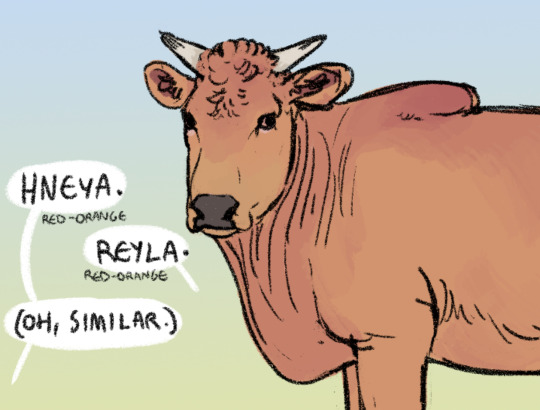

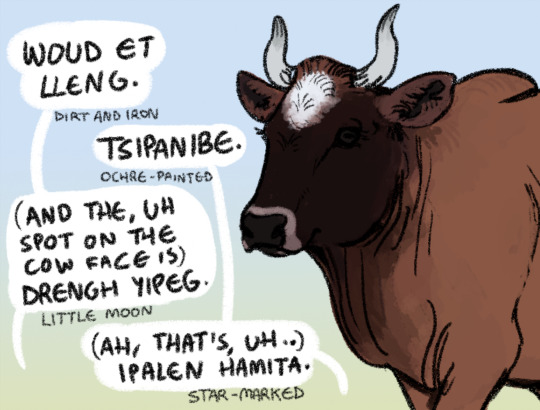
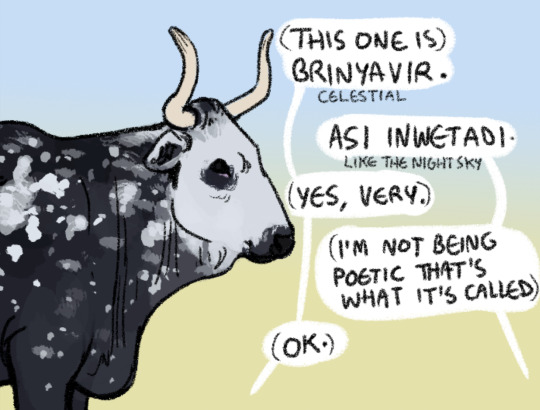
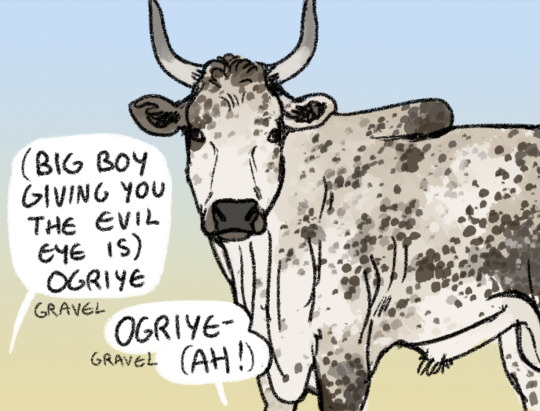
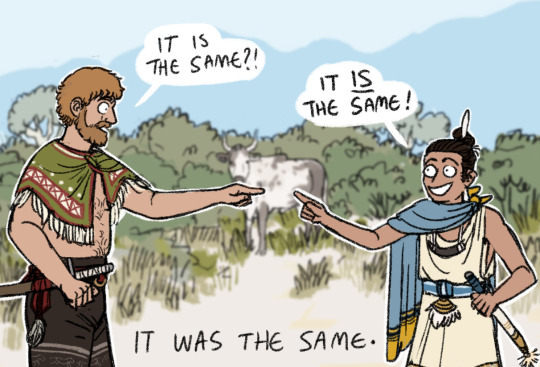
Comparing livestock color-words.
Both the Chenahyeigi and Wardi languages are derived from peoples who have been pastoralists for millennia, and both have an absolute ton of words for livestock coloration.
Both languages have had at least some mutual influence for about a thousand years (to varying extents by dialect, depending on geography/trade connection) so you'll see similar or identical words crop up here and there.
THE WORDS:
Hneya - [hne:ʝɑ] or [hne:jɑ] (whether the ʝ sound is retained in speech and to what extent varies by dialect)
Straightforwardly refers to bright reddish-orange color, but is mostly used for animals rather than other orangeish things. The word Was probably influenced by an older form of the Wardi 'reyla', and absorbed with the introduction of orange colored cattle. It may have been merged with the Chenahyeigi '(h)ne', which is the root of several red color-related terms.
Reyla - [rejlɑ]
This is a Wardi word for most reddish-orange hues in general. When applied to livestock, it refers to solid orange coats without spotting/masks/notable countershading.
Fels akhri - [fels] [ɑ:khɾi]
Translates readily as 'storm cloud' (the 'storm' here specifies thunderstorms). When applied to livestock, it describes fur that is rich dark blue-gray with white guard hairs.
Aganne - [ɑgɑ:ne]
This doesn't actually translate to 'night sea' in a straightforward manner, but as a color word it's poetically associated with dark seas, at night or in storms. When used for livestock, it describes this coloration exclusively.
Woud et lleng - [woʊd] [ɛt] [ɬeŋk]
Woud is the word for rich moist soil specifically, lleng refers to laterite and its association with iron deposits. This phrase is used to describe livestock with dark brown heads and and orange-brown bodies.
Tsipanibe - [t͡sipɑnibe]
This would be more literally translated as 'ochred'. Many Wardi words with the -ibe stem from verbs or nouns modified to indicate that the subject matter has 'received' an action or concept. (Examples of such words are long-established linguistically, you can't just add '-ibe' to any noun or verb). This one takes the root 'tsipan' (ochre) and applies it to the subject matter (cattle coloration).
Livestock with a dark brown or black head and orange-brown body are given this description, the idea being that their bodies look like they've been painted in ochre. This word is extremely rare outside of this context (you would usually just say the full 'ochre-painted' to convey this idea for other things)
Drengh yipeg - [dɾeŋg(h) yɪpɛ:g]
This is pretty straightforwardly 'little moon'. Yipeg comes from the same root as the Wardi 'hippe' for 'small', while drengh refers to the appearance of the moons in the sky (rather than the gods they embody). It's used to describe small round white blaze marks.
Ipalen hamita - [ipɑlɛn (h)ɑmitə]
Straightforwardly 'star marked', used for small round white blaze marks. Wardi actually does have a 'moon marked' (ipalen amit) to describe round white blazes that entirely cover the animal's forehead.
Brinyavir - [bɾi:nʝɑvir] (ʝ is retained for this word in most dialects)
This one is not directly translatable, 'celestial' or 'heavenly' just function closely enough. The word conceptually relates to stars but most specifically describes a layer of sky in which the afterlife rests (brinyavir is part of the phrase I translate as 'celestial fields'). The cattle there are said to have these markings. The stars in the night sky are sometimes playfully described as the spots of these cattle (though not literally, in Chenahyeigi cosmology stars are spirit-inhabited bonfires lit along pathways through the heavens).
As a color word for livestock, brinyavir refers to this rare (I Think nonexistent irl) white-spotted black coloration, due to both resembling the stars and the cattle that are moved among them.
Asi inwetadi - [ɑsi in:wetɑ:di]
This directly means 'like night sky', and is applied to this coat pattern with a similar underlying logic- it looks like a starry night sky. You will often see asi (like/akin to) retained in place or animal names like this, and it is sometimes part of names for people (the name Asinya is derived from a contracted 'like the sun').
Ogriye - Chenahyeigi: [oʊ:gɾije] Wardi: [oʊgɾi:je]
This word is (or was) a way to say 'gravel' or 'gravelly' in both Chenahyeigi and Wardi, and is pronounced very similarly in both (with the only significant difference being emphasis)
In Chenahyeigi it is a loanword from the Wardi language family, most likely received in the exchange of cattle of this coloration. It is retained in general speech as a word for gravel, more specifically the adjective 'gravelly'.
The word is mostly obsolete in contemporary Wardi, speakers do not know it used to mean 'gravel' (though it sounds close enough to assume a connection, the word is 'ogri') and exclusively use it to describe this livestock coloration (one of the more common among Wardi native cattle).
---
Also here's some cow lore.
There's some fairly tremendous diversity in Wardi cattle herds, given they have genetic influence from at least two separate aurochs domestication events (also distant and negligibly minor influence from one instance of bison domestication) and from multiple relatively isolated domestic cattle populations. Present day herds within Wardi provincial territory near-ubiquitously have at least some ancestry from the kulustaig and the Burri tepang cattle.
The ancestors of the Wardi native cow have been in the region for at Least 5,000 years. Burri cattle Possibly could have had tiny, isolated introductions between 2500-3000 years ago (this is extremely unlikely, but maize Was probably introduced by seafaring proto-Burri peoples at this time) or at more recent points since, and the tepang was certainly introduced during Imperial Burri occupation. High quality cattle are also occasionally received in diplomacy with the present-day Different Entity that is the Burri Republic. The kulustaig cattle arrived with proto-Finnic migrants starting 1500 years ago, and is the biggest external genetic influence on Wardi herds. Small populations of Yuroma native cattle arrived with migrants 540 years ago, though these have been wholly absorbed into Wardi herds, with their biggest trace being genes for naturally polled horns. Some Finn cattle were extracted in the recent two decades of Wardi occupation, though not enough to have a noteworthy genetic impact on any herds.
Most of the cattle in this post show predominantly Wardi native cattle + kulustaig ancestry (this takes place in the Ephenni riverlands, where the ancestry of herds tends to be around 2:1). The one with the blaze has a delicate sloping muzzle that suggests Burri tepang ancestry, and also likely has a wild aurochs grandparent (the white ring around the nose is a telltale sign, as it usually vanishes within a few generations of introgression).
Diversity in color and coat pattern is culturally favored for Wardi cattle herds, and selective breeding for aesthetics is usually limited to the purpose of preserving unique coats. The average herd tends to be very colorful, though the one shown here is a bit of an outlier, the universe having mysteriously put in place perfect conditions to compare the words for a variety of coat patterns.
#My marginal comprehension of the IPA has advanced somewhat. For those who don't know : indicates the vowel/consonant beforehand#is long and () means a sound is marginal/optional/not articulated#The 'h's you see at the end of a lot of Chenahyeigi words are usually soft unvoiced exhalations and very subtle#It's part of the accent but not doing it doesn't change the meaning of the word in most cases#The Wardi language has a tendency of dropping H sounds at the beginnings of words over time/in certain dialects#(especially when followed by the [i] vowel. A lot of people pronounce hippegalga as just ippegalga) and in a lot of words#pronunciation of leading H's is essentially optional#One aspect of Wardi formal register is always enunciating these droppable H's
3K notes
·
View notes
Text
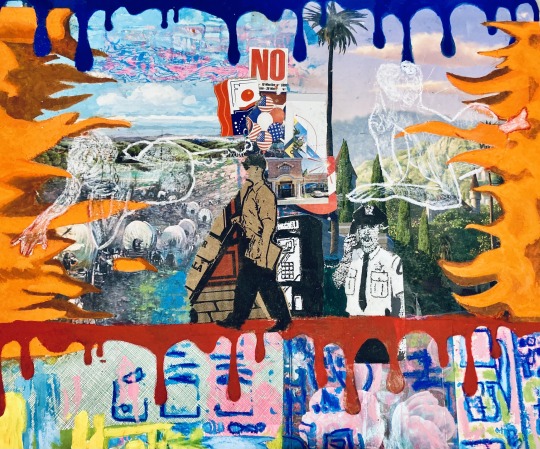
Convenient Covenant (NO) (2023)
collage, gouache, acrylic, wax pastels, colored pencils, China marker, and silkscreen ink on card
17" x 14"
#art#collage#mixed media#contemporary art#2023#drawing#painting#political art#dialectical#dialecticalrealism
3 notes
·
View notes